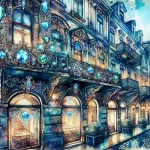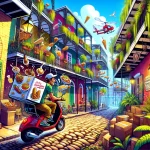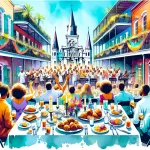New Orleans’ French Quarter is renowned for its lively music scene. At the heart of this cultural tapestry are the iconic band stands that dot the streets and squares of the Quarter. These band stands serve as the pulse of NOLA’s music scene, showcasing the city’s distinctive musical heritage and cultural diversity.
In This Article
TL;DR
- Band stands have been an integral part of the French Quarter’s cultural landscape for over a century, providing a stage for local musicians to share their talents.
- These band stands play a crucial role in preserving and promoting New Orleans‘ unique musical traditions, including jazz, blues, and brass band music.
- Prominent band stands in the French Quarter include those at Jackson Square, Royal Street, and Frenchmen Street, each offering its own unique musical offerings.
Historical Context of Band Stands in New Orleans
The origins of band stands in the French Quarter can be traced back to the late 19th century when the city’s music scene was blossoming. As jazz and blues gained popularity, musicians would gather in public spaces to perform for passersby. Over time, these impromptu performances evolved into organized events, with band stands being built to provide a dedicated space for musicians to play.
The development of band stands in the French Quarter is closely intertwined with New Orleans’ broader musical heritage. The city’s diverse cultural influences, including African, Caribbean, and European traditions, have shaped its music scene, giving rise to unique genres like jazz, zydeco, and brass band music. Band stands have played a vital role in nurturing and showcasing these musical styles, providing a platform for local artists to hone their craft and share their talents with the world.
Cultural events and festivals have also contributed to the popularity of band stands in the French Quarter. The New Orleans Jazz & Heritage Festival, French Quarter Festival, and Satchmo SummerFest are just a few examples of the many events that celebrate the city’s musical heritage and feature performances at various band stands throughout the Quarter.
Architectural Features of French Quarter Band Stands
The band stands in the French Quarter are not only functional spaces for musical performances but also architectural gems that reflect the city’s unique cultural influences. Many of these band stands feature ornate ironwork, intricate woodcarvings, and colorful tilework, showcasing the craftsmanship and artistic flair that New Orleans is known for.
One of the most common architectural styles found in French Quarter band stands is the Victorian style, characterized by its elaborate decorative elements and use of cast iron. The band stand at Jackson Square, for example, features a stunning cast-iron gazebo with intricate filigree work and a domed roof. Other band stands, like the one at Washington Artillery Park, incorporate more modern design elements while still paying homage to the city’s architectural heritage.
The materials used in the construction of French Quarter band stands also reflect the city’s cultural influences. Many band stands feature wrought iron, a material that is ubiquitous in New Orleans architecture, as well as cypress wood, which is native to the region and known for its durability and resistance to decay.
Prominent Band Stands in the French Quarter
Preservation Hall
Located on St. Peter Street, Preservation Hall is a cornerstone of the French Quarter’s jazz scene. This intimate venue has been hosting traditional jazz performances since 1961 and has become a must-visit destination for music lovers from around the world. The hall’s rustic interior and acoustic setup create an authentic atmosphere that transports visitors back to the early days of jazz.
The Palm Court Jazz Café
Situated on Decatur Street, the Palm Court Jazz Café is another iconic band stand in the French Quarter. This venue combines live jazz performances with delicious Creole cuisine, offering visitors a multisensory experience that showcases the best of New Orleans culture. The café features a spacious courtyard where patrons can enjoy their meals while listening to some of the city’s finest jazz musicians.
Frenchmen Street
While not a single band stand, Frenchmen Street is a must-visit destination for music lovers in the French Quarter. This vibrant street is lined with numerous live music venues, each with its own unique character and musical offerings. Some of the most popular band stands on Frenchmen Street include The Spotted Cat Music Club, d.b.a., and Blue Nile.
Musical Genres and Performances
The French Quarter band stands showcase a wide range of musical genres, reflecting the diverse cultural influences that have shaped New Orleans’ music scene. Some of the most common genres played at these band stands include:
Traditional Jazz
Often referred to as “New Orleans jazz,” this style of music originated in the early 20th century and is characterized by its improvisational nature, syncopated rhythms, and use of brass instruments. Preservation Hall is one of the best places in the French Quarter to experience traditional jazz performances.
Brass Band Music
Brass bands have been a staple of New Orleans’ music scene since the late 19th century. These bands typically feature a mix of brass instruments, such as trumpets, trombones, and tubas, along with percussion instruments like drums and cymbals. Brass band performances can often be found at outdoor band stands throughout the French Quarter, particularly during festivals and parades.
Blues
New Orleans has a rich blues tradition, with many local musicians putting their own spin on this classic American genre. Blues performances can be found at various band stands throughout the French Quarter, particularly on Frenchmen Street.
Zydeco
This lively genre of music originated in the Creole communities of Louisiana and combines elements of blues, R&B, and Cajun music. Zydeco performances often feature the accordion and washboard, creating a unique sound that is sure to get audiences dancing.
Many notable musicians and bands are associated with the French Quarter band stands, including:
Preservation Hall Jazz Band: This iconic band has been performing at Preservation Hall since the 1960s and has become synonymous with traditional New Orleans jazz.
Trombone Shorty: A native of New Orleans, Trombone Shorty is a Grammy-nominated musician who has performed at numerous band stands throughout the French Quarter, showcasing his unique blend of jazz, funk, and hip-hop.
Kermit Ruffins: Known for his lively trumpet playing and engaging stage presence, Kermit Ruffins is a fixture of the French Quarter music scene and can often be found performing at venues like the Blue Nile and Preservation Hall.
These performances not only entertain visitors but also play a crucial role in maintaining and promoting New Orleans’ unique musical traditions. By attracting tourists from around the world, the French Quarter band stands contribute to the city’s economy and help support local musicians and businesses.
Cultural Significance and Community Impact
The band stands in the French Quarter are more than just performance spaces; they are also important cultural institutions that play a vital role in the community. These band stands serve as gathering places for locals and visitors alike, providing a space for people to come together and celebrate the city’s rich musical heritage.
Many community events and celebrations in the French Quarter revolve around the band stands. During Mardi Gras, for example, brass bands can be found performing at various band stands throughout the Quarter, adding to the festive atmosphere of the celebration. Similarly, during the French Quarter Festival, which takes place every April, band stands serve as the main stages for the event, showcasing the talents of local musicians and attracting thousands of visitors to the area.
The band stands also contribute to the preservation and revitalization of local traditions. By providing a platform for musicians to perform traditional genres like jazz and brass band music, these band stands help keep these art forms alive and relevant in the modern era. Additionally, the presence of live music in the French Quarter helps create a vibrant and engaging atmosphere that draws visitors to the area, supporting local businesses and the economy.
Visitor Experience and Engagement
Visiting a band stand in the French Quarter is a must-do experience for anyone interested in New Orleans’ music scene. Here are some tips for making the most of your visit:
- Best times to visit: While live music can be found at band stands throughout the day, the best times to visit are typically in the evening, particularly on weekends. Many band stands feature multiple performances throughout the night, so be sure to check the schedule in advance.
- Enjoying the music and atmosphere: When visiting a band stand, don’t be afraid to let loose and dance along to the music. Many band stands have dance floors or open areas where visitors can move to the beat. If you’re not much of a dancer, simply sit back and enjoy the lively atmosphere and talented musicians.
- Supporting the musicians: Most band stands in the French Quarter operate on a tip-based system, meaning that the musicians rely on the generosity of the audience to make a living. If you enjoy the performance, be sure to tip the musicians or purchase one of their CDs as a way of showing your support.
Visitors can also contribute to the preservation of these cultural sites by attending performances, spreading the word about their experiences, and supporting organizations that work to maintain and promote the French Quarter’s musical heritage.
Future of Band Stands in the French Quarter
Despite their cultural significance, the band stands in the French Quarter face various challenges in modern times. Rising rents, noise complaints from nearby residents, and competition from other forms of entertainment all pose threats to the survival of these historic sites.
However, there are also many efforts and initiatives underway to preserve and maintain the relevance of the French Quarter band stands. Organizations like the New Orleans Jazz National Historical Park and the Preservation Hall Foundation work to promote and protect the city’s musical heritage, while events like the French Quarter Festival and Satchmo SummerFest help showcase the talents of local musicians and attract visitors to the area.
Technology and social media also play an increasingly important role in promoting and preserving the French Quarter music scene. Many band stands now have their own websites and social media pages, allowing them to connect with fans and promote upcoming performances. Live streaming and virtual performances have also become more common in recent years, providing new ways for people to experience the music of the French Quarter from anywhere in the world.
Despite the challenges, the future of band stands in the French Quarter looks bright. With the support of the community, the dedication of local musicians, and the enduring appeal of New Orleans’ unique musical traditions, these iconic performance spaces are sure to remain a vital part of the city’s cultural landscape for generations to come.






